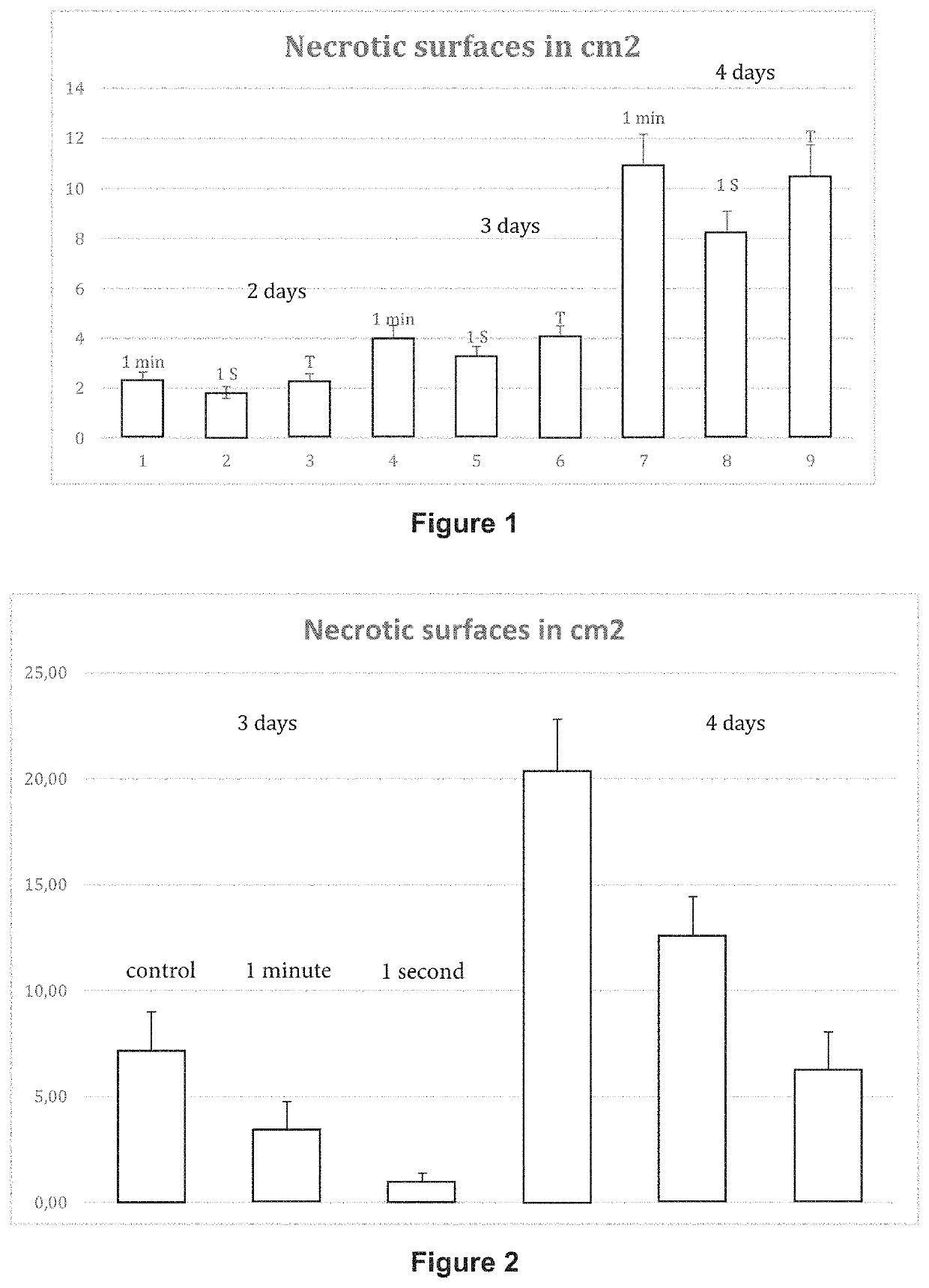Method for stimulating the resistance of plants to biotic stress by UV radiation exposure
a technology of biotic stress and radiation exposure, which is applied in the field of stimulating the resistance of plants to biotic stress by radiation exposure, can solve the problems of severe harvest loss, insufficient protection of agricultural crops against infections and damage caused by biotic stress, and difficulty in practical consideration of exploiting them
- Summary
- Abstract
- Description
- Claims
- Application Information
AI Technical Summary
Benefits of technology
Problems solved by technology
Method used
Image
Examples
example 1
[0077]5 cm2 of leaves of romaine lettuce are exposed to UV-C for 1 minute or for 1 second at equal wavelength and energy. The romain lettuce is inoculated with Botrytis cinerea 48 hours after the exposure.
[0078]Observations of the progression of lesions were conducted on leaves near to the treated leaves 2 days, 3 days and 4 days after inoculation. Evolution of necrotic surfaces in cm2 is shown on FIG. 1. After 4 days, the necrotic surface is 5% lower in lettuce treated with an exposure of 1 minute whereas it is 21% lower in lettuce treated with an exposure of 1 second. The irradiation exposure of 1 second is more effective to improve the resistance of plants than the irradiation exposure of 1 minute. In addition, surprisingly, the plant is less damaged with a short exposure than with a long exposure, both delivering the same energy.
example 2
[0079]5 cm2 of leaves of pepper are exposed to UV-C for 1 minute or for 1 second at equal wavelength and energy. 48 hours after the exposure the pepper is inoculated with Phytophtora capsici.
[0080]Observations of the progression of lesions were conducted on near leaves of the treated leaves 3 days and 4 days after inoculation. Evolution of necrotic surfaces in cm2 is shown on FIG. 2. After 4 days, the necrotic is 38% lower in pepper treated with an exposure of 1 minute whereas it is 69% lower in pepper treated with an exposure of 1 second. The irradiation exposure of 1 second is more effective to improve the resistance of plants that the irradiation exposure of 1 minute.
[0081]The method of the invention seems even more effective against biotrophic than against necrotrophic fungi.
example 3
[0082]5 cm2 of leaves of romaine lettuce are exposed to UV-C for 1 second repeated 4 times with an interval of 48 hours. 48 hours after the last exposure the romain lettuce is inoculated with Botrytis cinerea.
[0083]Observations of the progression of lesions were conducted on leaves near to the treated leaves, 2 days, 3 days, 4 days and 5 days after inoculation. Evolution of necrotic surfaces in cm2 is shown on FIG. 3. After 4 days, the necrotic surface is 31% lower in lettuce treated with an exposure of 1 second repeated.
[0084]The repetition of irradiation exposure brings an added value when compared to the absence of repetition (example 1): 31% reduction of lesion surface vs. 21%. The repetition of irradiation exposure of 1 second is more effective to improve the resistance of plants that the irradiation exposure of one exposure of 1 second.
[0085]In the two following examples, three light conditions were tested: control (no exposure to light), pulsed light exposure without filter ...
PUM
 Login to View More
Login to View More Abstract
Description
Claims
Application Information
 Login to View More
Login to View More - R&D
- Intellectual Property
- Life Sciences
- Materials
- Tech Scout
- Unparalleled Data Quality
- Higher Quality Content
- 60% Fewer Hallucinations
Browse by: Latest US Patents, China's latest patents, Technical Efficacy Thesaurus, Application Domain, Technology Topic, Popular Technical Reports.
© 2025 PatSnap. All rights reserved.Legal|Privacy policy|Modern Slavery Act Transparency Statement|Sitemap|About US| Contact US: help@patsnap.com



